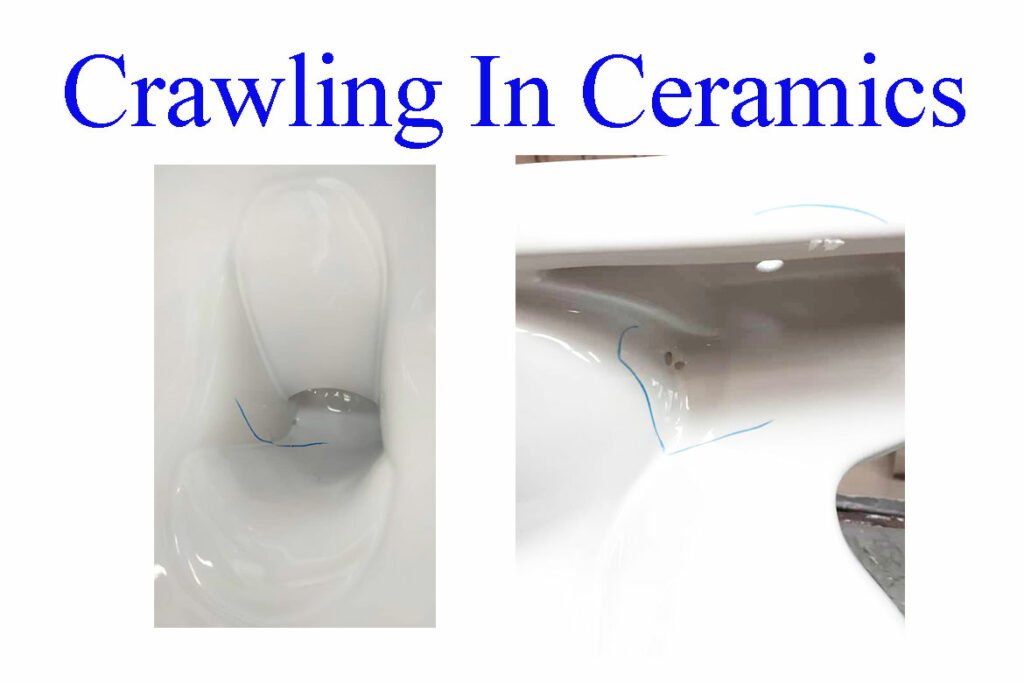Crawling in Ceramic-10 Causes & 10 Methods to Reduce
Crawling is a well-known defect encountered daily in ceramic sanitaryware production, akin to issues like cracks and pinholes. This article aims to outline the various causes of crawling and provide remedies to mitigate this defect. While there may be multiple reasons for crawling, implementing the remedies listed below can effectively address approximately 90% of crawling defects. Whether you are involved in sanitary ware production or any other ceramic manufacturing unit, the insights shared in this article are universally applicable. Let’s delve into the details and explore ways to minimize crawling defects in ceramic production.

What is crawling in Ceramics?
A portion of the glaze leaves the body exposed; It may look like the area never glazed, the thickness of the edge of the glaze may seem higher than the glaze in another area.
PRINCIPLE OF CRAWLING DEFECT:
The action of surface tension in the glaze crack leads to the crawling defect.
Causes of Crawling In the Ceramic Wares
1) Ware Is Hot: The glaze is sprayed on the ware when it is too hot, then there will be a shrinkage difference between the bottom layer and the top layer of the glaze, which can cause a crack in the glaze due to surface tension difference. If the sanitary ware is unloaded from the dryer and sprayed immediately without wetting the ware properly, then there is a chance for crawling.
2) Body Contains High Moisture Content: If the spraying is done when sanitaryware not dried properly then during firing because of the rapid heating there are chances of crawling in the ware.
3) Thickness Difference Between The Glaze: When there is a difference between the thickness of the glaze layer due to surface tension, the possibility of a crack in the glaze which leads to crawling during firing.
4) Foreign Materials Present In The Body: Foreign materials like dust, talc used in casting, oil and grease cause poor adhesion between the glaze and the wares. Because of the poor adhesion crawling may cause during firing.
5) Sharp Edges In The Body: When glaze is sprayed on a sharp edge are, due to the less absorbing capacity in the edges, there is a chance of improper adhesion, this may cause crawling during firing of the wares.
6) Excess Glaze Thickness: Excess thickness of glaze can cause crawling. In the sanitaryware sump area we may face these issues.
7) The glaze is Finer: If the glaze contains more fine materials there is the possibility of excessive shrinkage which can lead to crawling in the ceramic body.
8) Insufficient Binder Or Degraded binder: Sufficient binder to be added to glaze to improve the adhesion between the body and glaze.A degraded binder in the glaze also reduces the adhesive property of the glaze.
9) High clay Content In The Glaze: High shrinkage material in glaze composition can lead to high shrinkage during drying of the glaze this can cause the crack during shrinkage and the crawling during firing.
10) High Zinc oxide: Zinc oxides have the property of high hydration, the shrinkage will be more when drying which can cause a crack in the glaze.
11) Sulphate content On The Body Surface: The sulphate content on the body surface causes poor adhesion between the body and the glaze.
Remedies
Below is the list of remedies for crawling defect:
1) Spray the glaze when the body is below 40oC
2) Make sure the body moisture content from the dryer below 0.5%.
3) Maintain the same thickness in all the area of wares.
4) Sponge properly to remove the foreign materials present on the body.
5) Use a wet sponge to remove the sulphates present on the body surface to get proper adhesion between body and the glaze.
6) Wetting the surface of the body with the sponge to make sure the shrinkage of the glaze is not rapid.
7) Reduce the clay content in the glaze, can also replace with calcined clay
8) Add the required amount of binder and add anti-bacterial additives to avoid the binder degradation binder also helps to reduce the drying time of glaze.
9) Don’t over grind the glaze, maintain the required particle size distribution.
10) Make sure the ware have enough to time dry before sending to the kiln, correctly using the pre-dryer in the kiln is very important. Usually, pre-dryer is called as glaze dryer, the purpose of pre-dryer in the kiln is to avoid the rapid heating of the glaze the slow drying of glaze ensures in the glaze.
Conclusion:
We have covered important cause and remedies for the crawling in the ceramic wares in this article. Let us know your view on this article by commenting below.
Written by : Venkat Mani
Venkat Mani is a Ceramic Engineering Graduate from India, working in Sanitaryware production line for 15 years. He shares Meaningful content related to sanitaryware professionals that others find useful.
One Comment
Leave A Comment
Crawling is a well-known defect encountered daily in ceramic sanitaryware production, akin to issues like cracks and pinholes. This article
A quick overview of the topics covered in this article.




Thank you for your information. it would be good for us.